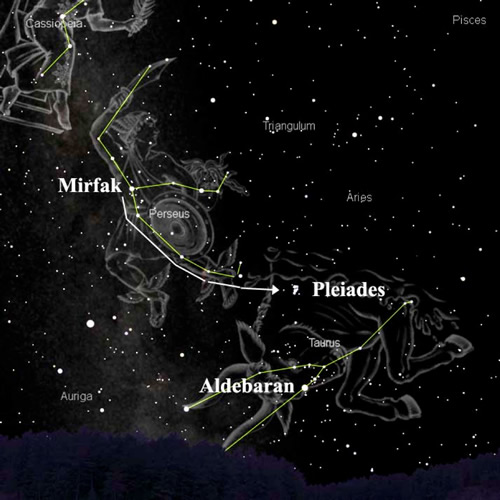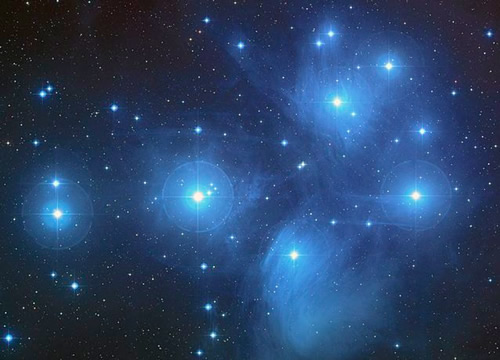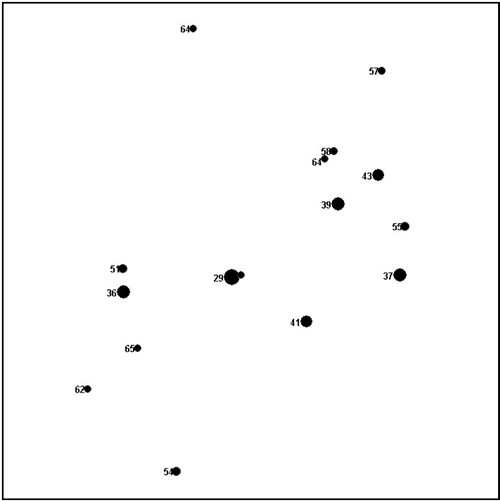
In winter, even just a casual glance at the sky will register the Pleiades star cluster. For northern hemisphere observers, the cluster is like winter's beauty mark, arriving with the darkening months and sitting high in the constellation Taurus, preceding the bright red star Aldebaran across the sky. It is easy to find, and punctuates the end of a beautiful sweep of stars beginning in Perseus with first magnitude Mirfak, along the eastern leg of the constellation.
This eye-catching cluster is quite young by astronomical standards, having emerged from the Merope Nebula within the last 100 million years, and some estimate it is as young as 20 million years, meaning it did not shine in the skies when the dinosaurs roamed the Earth. The cluster is our close neighbor, about 380 light years distant in our local arm of the Milky Way galaxy, and has about an 8 light year diameter. For perspective, only Alpha Centauri and Sirius are bright stars within 8 light years of Earth.
As Walter Scott Houston said of the Pleiades, "Even on the coldest of winter nights, when time spent at the telescope is better measured in minutes than hours, it would be a very un-amateur act not to look in on the Pleiades."
The cluster makes an excellent target for binoculars or a wide-field telescope, but require nearly two degrees to see all members in one field of view. The nebulosity is fleeting, and can be faintly glimpsed under excellent conditions, primarily around the star for which the nebula is named, Merope (the bottom star in the image below). In Deep Sky Wonders, Walter Scott Houston wrote of this fleeting nebulosity, saying: "On an ordinary night, there are usually a few wisps of nebulosity seen around the Pleiad Merope. But on really exceptional nights (or more likely, half hours), the glow swells out to encompass the entire cluster in a big cocoon."
Charles Messier catalogued the Pleiades as Messier 45, or M45, but he was not the first to notice the Pleiades. The cluster goes by many names, and its fame crosses many cultures. Ancient Greeks called it The Seven Sisters and the Japanese call it "Subaru" - you can see it as the logo of the car company. Ancient Persians used "Soraya" - which was also the name of the former Iranian empress. The British and Germans called it the Chick with Hens. Many people today see it, and mistake it for the Little Dipper. Perhaps we should refer to it as The Littlest Dipper? There are many variations, but the cluster is part of human records reaching as far back as Babylonia. It was mentioned in Homer's Iliad and Odyssey, referenced three times in the Bible, shows up in the Quran and in ancient Hindu mythology as well. This may be history's most famous star cluster!
On average, the naked eye sees the six brightest stars of the cluster. I've read reports of people counting up to fourteen members, naked-eye. My best is nine. The above chart shows the brightest members and magnitudes. How many can you see? Make a sketch then come back and compare it to the chart.
Despite the number of stars you're able to see, remember this: the cluster is actually comprised of over 1,000 confirmed members with a "tidal radius" of around 43 light years and total mass of around 800 suns. That's a big group of stars!
The Pleiades is an open cluster. Open clusters are comprised of young star systems. There are thousands of examples of these throughout our own Milky Way galaxy. They tend to occur in the spiral arms of galaxies, as that's where star formation is predominant.
In your pair of binoculars or telescope, you can see hundreds of open clusters, varying greatly in size, shape, density and brightness. Some, like the Pleiades, do not require anything other than your eyes and interest to see them. The Hyades in Taurus is an example of an older dispersing open cluster that can be seen without a telescope, as are the stars around Mirfak in Perseus. The stars of The Big Dipper are a highly dispersed old open cluster. Like children, growing up in their family home (their nebula, per se), the stars of open cluster eventually disperse - and move on, to new homes across our night skies.
The winter Milky Way is a fine sight, with many bright stars against a black background. The Pleiades are a jewel among them. Beautiful at the casual gaze, spectacular in almost any astronomical instrument, and should you try to discern the nebula, a challenge as well. Even on the coldest nights, take a few minutes to go outside and enjoy the great sight of Winter's Littlest Dipper.
Clear skies,
Mark
Constellation chart courtesy Starry Night Pro - sold by Orion Telescopes and Binoculars. Pleiades image from the Digital Sky Survey. Pleiades detail chart from The Sky software.
Mark Wagner is a life-long astronomy enthusiast and deep sky observer. He has spent the past twenty years popularizing amateur astronomy in the San Francisco bay area through his writing and community building. A past president of the San Jose Astronomical Association, he founded what is now the annual Golden State Star Party in California. Please post if you have comments, questions, sketches or images you've taken of the targets mentioned above.

























